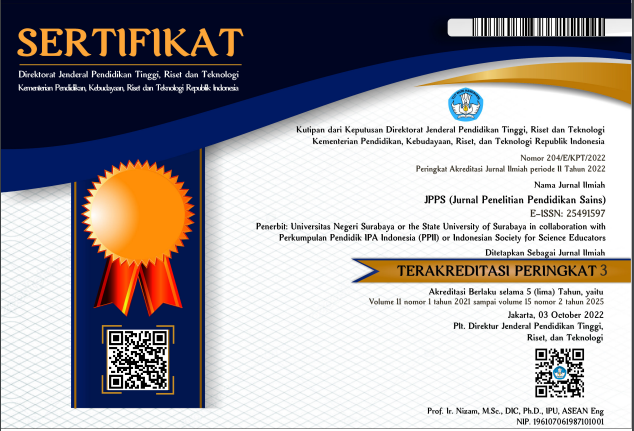Effectivity of Scientific Approach Oriented Learning in Heredity toward Senior High School Studentss Scientific Creativity
DOI:
https://doi.org/10.26740/jpps.v10n1.p1857-1873Keywords:
pembelajaran, pendekatan saintifik, kreativitas ilmiahAbstract
The purpose of this research was to investigate the effect of scientific approach oriented learning toward senior high school students scientific creativity. This learning was conducted in XII grade of SMA Muhammadiyah 2 Surabaya by using one-group pretest-posttest design. The methods of data collection were using observation, tests, and questionnaires. Data was analyzed using descriptive analysis quantitatively and qualitatively. The results showed that the learning is effective to enhance scientific creativity students based on N-gain and was significant stated through paired sample t-test. Then implementation of learning got students positive response. Overall, it can be concluded that scientific approach oriented learning was effective to train senior high school students scientific creativity.
Downloads
References
Aktamis, H., & Ergin, Ö. (2008). The effect of scientific process skills education on students' scientific creativity, science attitudes and academic achievements. Asia-Pacific forum on science learning and teaching, 9(1), 1-21.
Anderson, L.W., Krathwohl, D.R.,Airasian., P.W., Cruikshank, K.A., Mayer, R.E., Pintrich., P.R., Raths, J., &Wittrock, M.C. (2001). A taxonomy for learning, teaching and assesing: A revision of bloom taxonomy of educational objectives, a bridged edition. New York: Longman.
Ardaya, D.A. (2016). Penerapan pendekatan saintifik untuk meningkatkan pemahaman konsep materi IPA siswa sekolah dasar. Jurnal Pendidikan Guru Sekolah Dasar, 1(1), 72-83.
Arends, R.I. (2012). Learning to teach ninth edition. United States: The McGraw-Hill Companies, Inc.
Arikunto, S. (2012). Dasar-dasar evaluasi pendidikan edisi 2. Jakarta: PT Bumi Aksara.
Arwita, W. (2014). Scientific creativity in learning biology in senior high school tebing tinggi city, North Sumatra. Proceeding: The First International Seminar on Trends in Science and Education, 27,5-6.
Barrow, L.H. (2010). Encouraging creativity with scientific inquiry. Creative Education, 1(1), 1-6.
Borich, G.D. (1994). Observation skills for effective teaching 2nd edition. New York: Macmillan Company, Inc.
Cheng, V.M. (2010). Teaching creative thinking in regular science lessons: Potentials and obstacles of three different approaches in an Asian context. Asia-Pacific Forum on Science Learning & Teaching, 11(1), 1-21.
Direktorat Jendral Managemen Pendidikan Dasar dan Menengah. Kemendikbud. (2014). Peraturan Menteri Pendidikan dan Kebudayaan Republik Indonesia No.59 Tahun 2014 tentang Kerangka Dasar dan Struktur Kurikulum 2013 (Lampiran III). Jakarta: Kemendikbud.
Ekawati, E. Y. (2017). A model of scientific attitudes assessment by observation in physics learning based scientific approach: case study of dynamic fluid topic in high school. Journal of Physics: Conference Series, 795(1), 1-9.
Greenhill, V. (2010). 21st Century knowledge and skills in educator preparation. Partnership for 21st century skills. Retrieved from https://eric.ed.gov/?id=ED519336 (nonjurnal)
Hake, R. (1998). Interactive-Engagement versus traditional methods: A six-thousand-student survey of mechanics test data for introductory physics courses. American Journal of Physics - AMER J PHYS, 66(1), 64-74.
Hu, W., & Adey, P. (2002). A scientific creativity test for secondary school students. International Journal of Science Education, 24(4), 389-403.
Ibrahim, M. (2005). Asesmen berkelanjutan: Konsep dasar, tahapan pengembangan, dan contoh. Surabaya: Unesa University Press.
Jariyah, I.A. (2017). Efektivitas pembelajaran inkuiri dipadu Sains Teknologi Masyarakat (STM) untuk meningkatkan keterampilan proses sains peserta didik. Prosiding Seminar Nasional III Tahun 2017, 175-179.
Koray, Ö., & Köksal, M. S. (2009). The effect of creative and critical thinking based laboratory applications on creative and logical thinking abilities of prospective teachers. Asia-Pacific Forum on Science Learning & Teaching, 10(1), 1-12.
Liang, J. C. (2002). Exploring scientific creativity of eleventh grade students in Taiwan (Doctoral dissertation).
Lin, C., Hu, W., Adey, P., & Shen, J. (2003). The influence of CASE on scientific creativity. Research in Science Education, 33(2), 143-162.
Knippels, M.C.P., Waarlo, A.J., & Boersma, K.T. (2005). Design criteria for learning and teaching genetics. Journal of Biological Education, 39(3), 108-112.
Mahtari, S., Nur, M., & Tukiran, T. (2017). Pengembangan prototipe buku guru dan buku siswa ipa dengan penemuan terbimbing untuk melatihkan kreativitas ilmiah siswa SMP. JPPS (Jurnal Penelitian Pendidikan Sains), 5(2), 924-930.
Masruroh, M., Widodo, W., & Hidayat, M.T. (2016). Pengembangan perangkat pembelajaran berbasis inkuiri terbimbing untuk meningkatkan kreativitas ilmiah siswa SMP. JPPS (Jurnal Penelitian Pendidikan Sains), 5(2), 1061-1067.
Mohamed, A.H. (2006). Investigating the scientific creativity of fifth-grade students. Arizona: The University of Arizona.
Munandar, U. (2009). Pengembangan Kreativitas Anak Berbakat. Jakarta: PT. Rineka Cipta.
Nur, M. (2008). Buku Panduan Keterampilan Proses dan Hakikat Sains. Surabaya: Universitas Negeri Surabaya Pusat Sains dan Matematika Sekolah.
Penick, J.E. (1996). Creativity and the value of questions in STS. Suny Press.
Pekmez, E.S., Aktamis, H., Can, B.T., & Ergin, O. (2005). Developing scientific creativity test. Asia-Pasific Forum on Science Learning and Teaching, 23(1), 1-6.
Ratumanan, G.T., & Laurens, T. (2011). Evaluasi hasil yang relevan dengan memecahkan masalah problematika belajar dan mengajar. Bandung: CV Alfabeta.
Rustaman, N. Y. (2011). Pendidikan dan penelitian sains dalam mengembangkan keterampilan berpikir tingkat tinggi untuk pembangunan karakter. Bandung.
Sari, S., Aryana, D.M., Subarkah, C.Z., & Ramdhani, M.A. (2018). Multimedia based on scientific approach for periodic system of element. IOP Conference Series: Materials Science and Engineering, 288(1), 1-6.
Sharma, N. (2015). Scientific creativity in relation to cognitive style and achievement in Science of secondary school students. Educational Quest-An International Journal of Education and Applied Social Sciences, 6(1), 25-29.
Slavin, R.E. (2011). Educational psychology: Theory and practice, 9th edition. Pearson Education.
Sudjana, N. (2009). Penelitian dan Penilaian Pendidikan. Bandung: Sinar Baru Algesindo.
Suyidno, N., Yuanita, L., Prahani, B.K., & Jatmiko, B. (2018). Effectiveness of Creative Responsibility Based Teaching (CRBT) model on basic physics learning to increase students scientific creativity and responsibility. Journal of Baltic Science Education, 17(1), 136-151.
Utami, A.U., & Murti, S.C.C. (2018). The effectiveness of scientific approach-based science learning materials to educate students science literacy. JPPS (Jurnal Penelitian Pendidikan Sains), 8(1), 1553-1557.
Downloads
Published
How to Cite
Issue
Section
 Abstract views: 463
,
Abstract views: 463
, PDF Downloads: 704
PDF Downloads: 704












